When I scroll through the number of health issues on Facebook chicken groups I’m struck by some recurring themes: lots of chicken keepers are ill prepared for emergencies; when folks ask for help they often don’t provide a full picture of symptoms and timelines that would assist online helpers; and that so many illnesses share the same symptoms.
One of the most common refrains is “Help, my chicken is limping”. The go-to responses often include advice to check for bumblefoot or an injury. That’s a good start, but what if that’s not it? That got me to thinking about the myriad of conditions that affect our birds include issues with unusual gait, weakness, difficulty walking and leg paralysis. Some are directly related to a problem with the foot or leg, but others are less obvious.
I decided to do some online reading and catalogue various conditions that include limping or difficulty walking as one of its common symptoms. Here’s an overview: click on the highlighted terms for links to complete articles.
Bacterial & Viral Diseases
Avian Encephalomyelitis is a virus that mostly affects chicks and young birds. AE shares some of the same symptoms as Marek’s, Newcastle, ingesting toxins and vitamin deficiencies (e.g. A, D, E, riboflavin), primarily loss of muscle control.
Osteo-Arthritis is an orthopedic condition involving pain and inflammation, damage and loss of function of the joints. Causes include infection, trauma, degenerative changes or metabolic disorders. Birds can also develop articular gout, another form of arthritis.
Bumblefoot is a broad term that includes any inflammatory or degenerative condition affecting chicken feet. It’s most often a bacterial (i.e. Staphylococcus, Streptococcus or E.coli) infection with swelling or black lesions on the foot pad.

Bumblefoot (bitchin’ chickens) 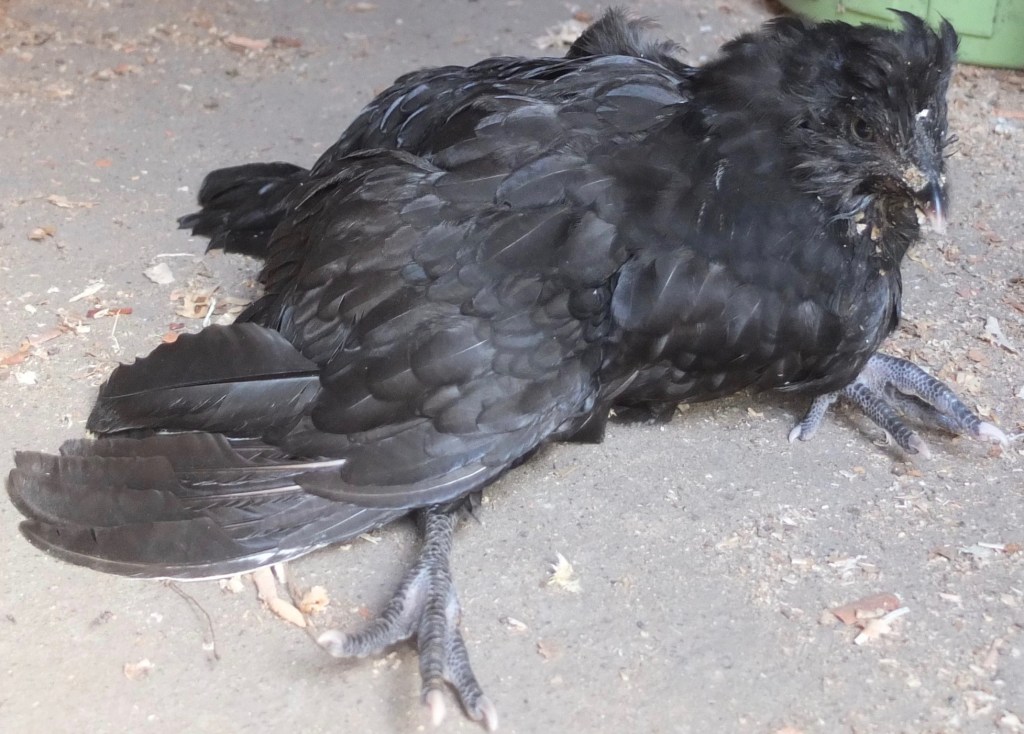
Marek’s Disease (bitchin’ chickens)
Fowl Cholera (Pasturella) Symptoms and lesions are generally related to localized infections of the sternal bursae, wattles, joints, tendon sheaths and footpads, which are often are swollen.
Marek’s Disease is a virus that affects immune system cells, which are involved in controlling the bird’s response to infection. Cells are not killed by Marek’s, but are changed in a way which will eventually kill the bird. There are a number of strains with varying symptoms: the visceral version causes internal cancerous tumours, while another form results in limping and paralysis of the neck, wing or leg.
Osteomyelitis is a Staphylococcus aureus infection in the bone spread through the bloodstream or surrounding tissue. Bone infections can cause permanent damage requiring amputation. Chickens can develop osteomyelitis in their feet and legs if they have an existing injury or wound, such as bumblefoot. Bacteria can enter through a bone fracture.
Nutritional
Atherosclerosis is what your doctor would refer to as cardiovascular disease and your grandmother would call hardening of the arteries. Chickens fed the wrong diet are just as susceptible to getting it as people who eat similar foods. The result of a high cholesterol diet is the collection of excess fat on their artery walls and the scarring and build-up called plaque hardens, narrowing the arteries and obstructing blood flow.
Gout is the result of either the production of too much uric acid or, more commonly, decreased kidney function enabling excess uric acid to cause damage to various internal systems. Birds with impaired kidneys may not be able to get rid of uric acid as efficiently, leading to a build-up in their blood and uric acid deposits within the joints and in visceral organs or other tissues. Over time, these deposits will grow to form masses of uric acid crystals. The acid itself isn’t toxic but the resulting crystals cause damage – sometimes severe – to kidneys, heart, lungs, air sacs, intestines and joints.
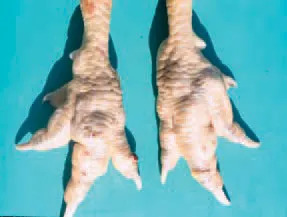
Articular Gout 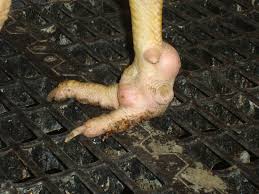
Mycoplasma Synoviae 
Mycoplasma Synoviae
Mycoplasma Synoviae (MS) is a bacteria that causes a wide variety of damage to joints, tendons, tissues, organs and the respiratory system. Historically it was seen as a disease which affected the synovial membrane of joints and tendons, but is now becoming more common in multi-age flocks presenting as an upper respiratory tract illness.
Osteoporosis is caused by the depletion of body stores of calcium during high egg production or a metabolic malfunction that impairs calcium absorption.
Rickets is a deficiency or imbalance of calcium, vitamin D3 and/or phosphorous. It can be caused by an improper diet, medications and toxic molds. It’s most common in young meat birds causing inadequate bone mineralization.
Vitamin B1 (Thiamine) Deficiency Thiamine is essential for the production of energy from glucose or the conversion of glucose to fat storage. The brain’s energy comes from the breakdown of glucose, a biochemical process requiring thiamine. Without it basic energy functions are impacted leading to systematic problems. When your birds are deprived of thiamine they become more vulnerable to neuromuscular issues and those affecting the heart, nerves and digestive system.
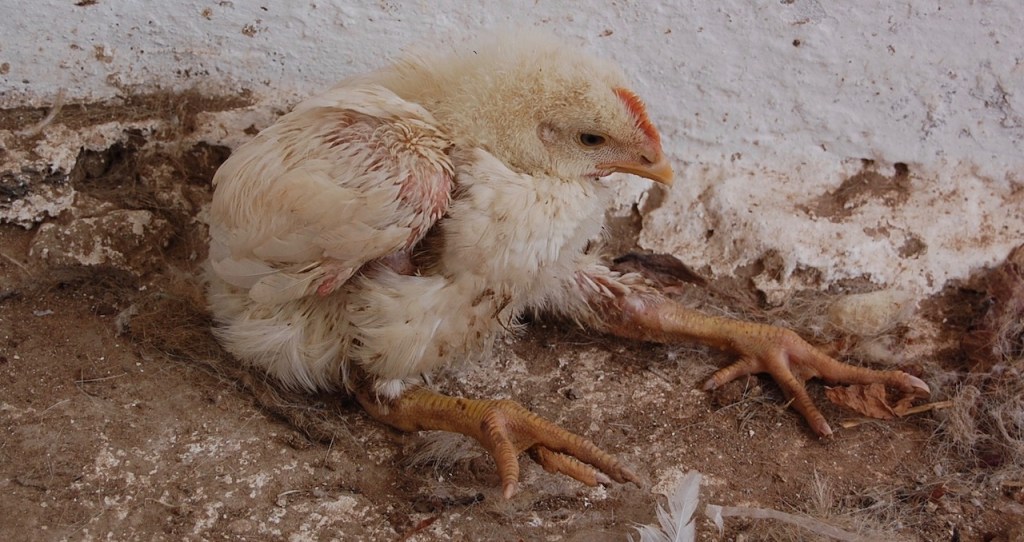
Thiamine Deficiency (Poultry DVM) 
Curled Toes
Vitamin B2 (Riboflavin) Deficiency results in Curly Toe Paralysis caused by peripheral nerve damage and degeneration of the sciatic nerves (back of the chick’s leg to the foot). If untreated the damage will become permanent.
Vitamin E Deficiency Nutritional Muscular Dystrophy (White Muscle Disease) involves progressive weakness and degeneration of the muscles that control movement. Affected chicks are often unable to stand or walk, and are seen on the ground with their legs spread to the sides.
Weight Obesity, whether in people or chickens, can put strain on the joints of the legs causing deterioration, inflammation and limping.
Miscellaneous
Breed Advancements in meat bird genetics combined with improved diet and enhanced feed conversion efficiency have led to larger breast muscle, increased growth rate, and skeletal and leg problems
Hardware Disease (Lead Poisoning and Zinc Toxicity) Eating pieces of metal can perforate the digestive tract and cause toxicity. Zinc (e.g. galvanized hardware and wire) is absorbed into the bloodstream and damages red blood cells causing them to rupture. The end result is kidney failure. Lead (e.g. paint chips, gunshot, fishing gear) when ingested often stays in the digestive system and acts as a strong neurotoxin. Over time it is released into the bloodstream, resulting in anemia, interference with the bird’s ability to absorb calcium and neurological issues.
Injury can include sprains or bone fractures.
Slipped Tendon can be caused by vitamin deficiencies in chicks, but is mostly a result of walking on slippery surfaces in the incubator or brooder. The tendon in the lower leg slips out of the groove on the back of their leg causing the leg to turn outward.
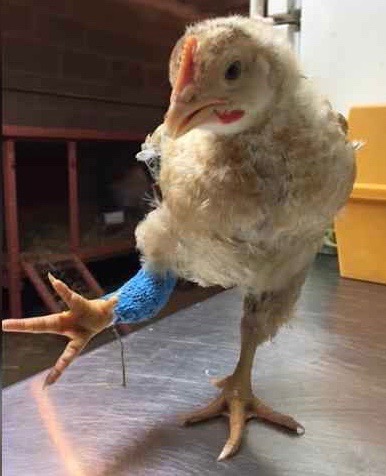
Slipped Tendon 
Splayed Leg (grit.com)
Splayed or Spraddle Leg is a common issue for newly hatched chicks, usually a result of incubation issues. It can involve one or both legs, most commonly both, causing them to extend outward to the sides of the chick’s body. The condition can be treated and reversed.
One of the frustrations of keeping chickens is they get sick and their symptoms are often vague or could be one of many issues. If one of your birds experiences loss of balance, leg paralysis or limping it would help to conduct a thorough physical exam to see if you can find more symptoms. If you put your finger under your bird’s foot pad can she curl her toes around it? If not, that’s a sign of paralysis.
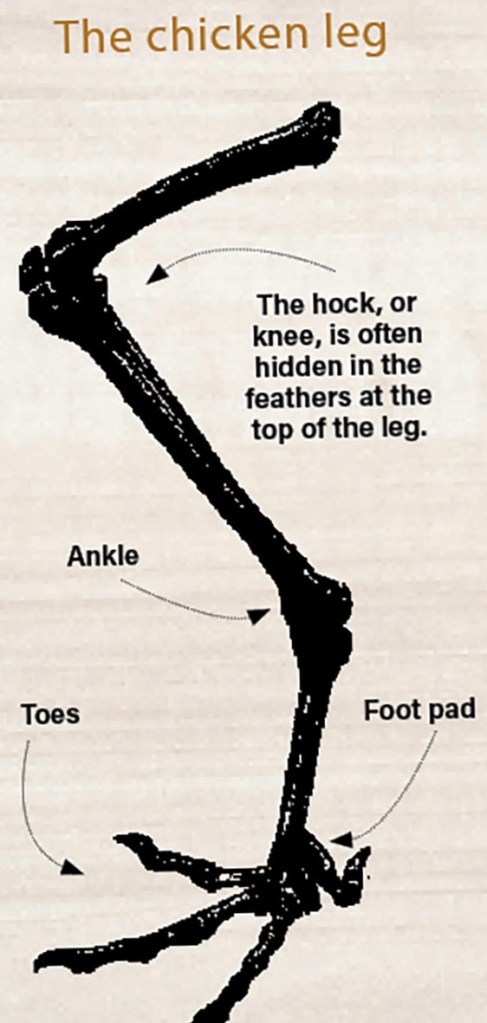
(thisNZlife) 
(Mary Britton Clouse)
If you post online seeking assistance or take your chicken to a veterinarian for an assessment it would be useful to have a complete list of symptoms, as well as photos or video if applicable. All of that information can help narrow a diagnosis and get you one step closer to potential treatment.
Don’t throw every possible treatment at a vulnerable bird without a firm diagnosis or you may unintentionally be wasting time, or make things worse.
Credits: Merck Veterinary Manual; Poultry DVM; Poultry Site Featured Photo: Pets4Home
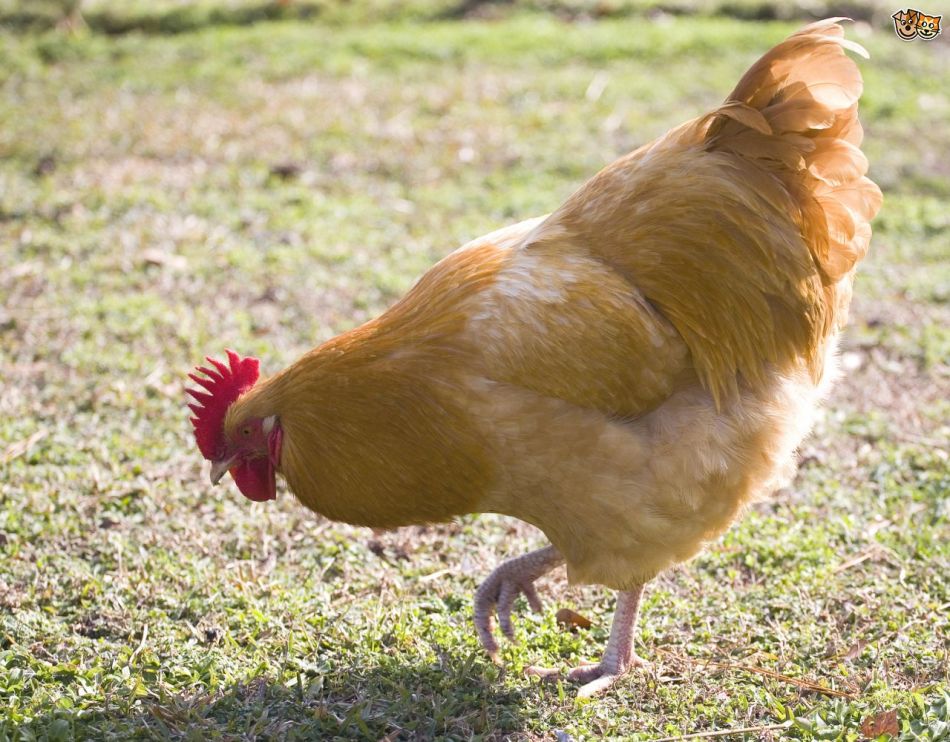
Great info!
LikeLiked by 1 person